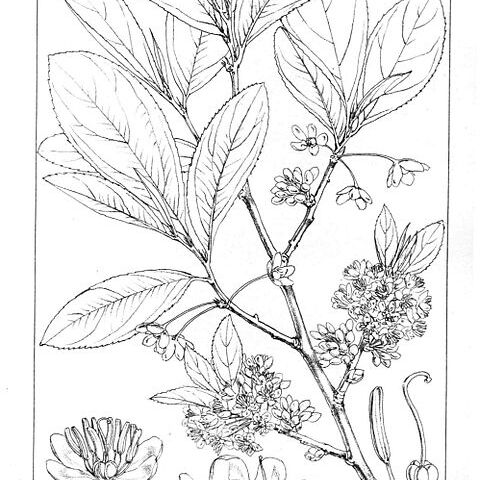Trees or large shrubs, with spreading branches. Stipules small, free, often more or less laciniate, caducous. Leaves chartaceous, glossy above; nerves strongly curved to the apex, often some of the lower ones partly parallel to the margin, the higher ones joining successively; veinlets branching, ±transverse. Inflorescences thyrsoid but of umbelloid appearance, made up of simple or compound, distichously arranged, shortened cymes; rachis often growing on vegetatively after flowering; bracts small, caducous, often many at base of inflorescence with small, axillary buds; pedicels filiform, slightly lengthening and turning red in fruit, ultimately caducous. Flowers with a ±hemispherical distinctly tumid torus, becoming red in fruit. Sepals 5, enlarged, fleshy and red in fruit. Petals 5 (–10), white or yellow. Stamens 10 (or many); filaments subterete; anthers dehiscing from the apex downwards by longitudinal slits. Ovaries 5 (–10), obovoid; ovule camptotropous, epitropous, ±annularly curved around 2 connecting intrusions of the endocarp; stigma small. Fruits 1–2 (–5), reddish, turning black or almost so when ripe.
Glabrous trees, shrubs or subshrubs with yellow pigment under the bark. Leaves petiolate; lamina entire to glandular-serrate with characteristic venation; stipules free, longitudinally striate, laciniate or deeply divided into linear segments, often persistent on young shoots. Flowers solitary or in panicles or fascicles, the fascicles sometimes forming spikes or heads, terminal or at base of young growth. Sepals (4–)5, usually quincuncially imbricate in bud, persistent and becoming red and coriaceous in fruit. Petals (4–)5, white to pink, deciduous. Stamens (8–)10–20(–22), free; anthers yellow, dehiscing by longitudinal slits, deciduous; filaments slender, persistent. Carpels (3–)5–10, free at base, 1-ovuled; styles slender, gynobasic with small stigmas. Fruit of 1-several free drupelets with fleshy mesocarp and with internal projections of endocarp. Seeds curved, without endosperm.
Leaves petiolate; lamina with margin glandular-serrulate or entire, and characteristic nervation of ascending primary laterals linked by secondary laterals (see specific descriptions); stipules markedly longitudinally striate, laciniate or deeply divided into linear segments, free, persistent on first-year shoots (at least in the African spp.).
Inflorescence paniculate or fasciculate or reduced to a single flower, or fascicles secondarily aggregated into spikes or capitula, terminal or at the base of current year’s growth; bracts striate, laciniate, persistent or deciduous; pedicels articulated at the base.
Stamens (8) 10–20 (22), free; anthers yellow, dehiscing by longitudinal slits, deciduous; filaments ± slender, approximately equal in length to the anthers, persistent.
Seeds curved, without endosperm but with an internal projection of the endocarp round which the embryo develops; embryo curved, incumbent or accumbent, isocotylous.
Carpels (3–4) 5–10, apparently free at the base, 1-ovulate; styles slender, gynobasic, completely united; stigmas terminal, scarcely enlarged.
Sepals (4) 5, imbricate (usually quincuncial) in bud, white or pink in flower, persistent, enlarging and becoming red and coriaceous in fruit.
Fruit of 1 to several free black 1-seeded drupelets with fleshy mesocarp, inserted on the enlarged red receptacle.
Trees, shrubs or shrublets, glabrous, with yellow pigment under the bark.
Petals (4) 5, white to pink, not or scarcely unguiculate, deciduous.

